
|
Astronomy Picture Of the Day (APOD)
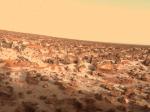 Could Hydrogen Peroxide Life Survive on Mars
Could Hydrogen Peroxide Life Survive on Mars
28.08.2007
Is there life on Mars? Although no unambiguous evidence for indigenous life on Mars has ever been found, a more speculative question -- could some life forms survive on Mars -- has taken on a new twist.
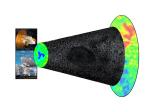 Huge Void Implicated in Distant Universe
Huge Void Implicated in Distant Universe
27.08.2007
What has created this huge empty area in the universe? No one is yet sure, and even the extent of the estimated billion-light year void is being researched. The void is not a hole...
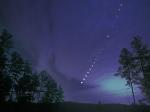 A Total Lunar Eclipse Over North Carolina
A Total Lunar Eclipse Over North Carolina
26.08.2007
This coming Tuesday, our Moon will appear to disappear. A similar total lunar eclipse is seen above in a time lapse image captured in 2003 over North Carolina, USA. As the Earth moves between the Moon and the Sun, the Earth's shadow fell on the moon, making it quite dark.
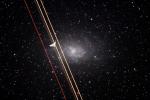 Just Passing Through
Just Passing Through
25.08.2007
M33 is a big, beautiful spiral galaxy a mere 3 million light-years away, understandably a popular target for enthusiastic astro-imagers. Just as understandably, interfering satellite trails and airplane streaks that are becoming more common in planet Earth's busy night sky are processed out of their finished images.
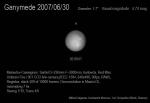 Astronomer s Moon
Astronomer s Moon
24.08.2007
Jupiter is an astronomer's planet -- its large size and contrasting global cloud belts and zones allow detailed studies with a range of earthbound telescopes. On the other hand, most telescopic views of Jupiter's moons usually show only featureless, tantalizing points of light hovering near the ruling gas giant.
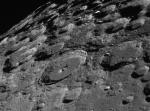 Southern Moonscape
Southern Moonscape
23.08.2007
The Moon's south pole is near the top of this sharp telescopic view looking across the southern lunar highlands. Recorded on August 3rd from Tecumseh, Oklahoma, planet Earth, the foreshortened perspective heightens the impression of a dense field of craters and makes the craters themselves appear more oval shaped.
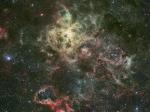 Tentacles of the Tarantula Nebula
Tentacles of the Tarantula Nebula
22.08.2007
The largest, most violent star forming region known in the whole Local Group of galaxies lays in our neighboring galaxy the Large Magellanic Cloud (LMC). Were the Tarantula Nebula at the distance of the Orion Nebula -- a local star forming region -- it would take up fully half the sky.
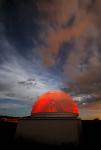 A Red Dome Under the Big Dipper
A Red Dome Under the Big Dipper
21.08.2007
Why would the dome of a telescopic observatory appear translucent red? As one of the telescopes of the Etscorn Observatory of New Mexico Tech waited to inspect small portions of the night sky, playful observers decided to make this unusual image.
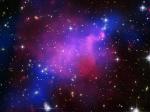 Cluster Crash Illuminates Dark Matter Conundrum
Cluster Crash Illuminates Dark Matter Conundrum
20.08.2007
Huge clusters of galaxies are surely colliding in Abell 520 but astrophysicists aren't sure why the dark matter is becoming separated from the normal matter. The dark matter in the above multi-wavelength image is shown in false blue, determined by carefully detailing how the cluster distorts light emitted by more distant galaxies.
 A Sonic Boom
A Sonic Boom
19.08.2007
Is this what a sonic boom looks like? When an airplane travels at a speed faster than sound, density waves of sound emitted by the plane cannot precede the plane, and so accumulate in a cone behind the plane.
|
January February March April May June July August September October November December |
|||||||||||||||||||||||||||||||||||||||||||||||||